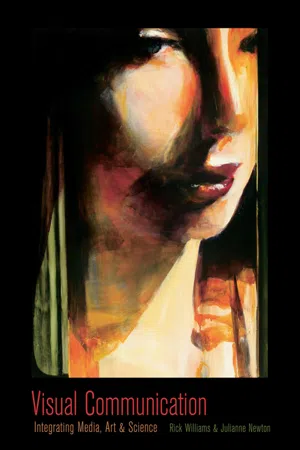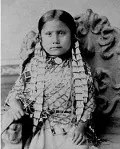CHAPTER ONE
Seeking Dynamic Balance: The Shaman, The Scientist, and the Theologian
Let us put our minds together and see what life we can make for our children.
— Sitting Bull, Lakota Sioux, 1877
Figure 1.2. Standing Holy, Sitting Bull’s Daughter, by D. F. Barry, 1885, Bismarck, Dakota. Photographic print on cabinet card, courtesy of the Library of the Congress Prints and Photographs Division, LC-USZ62- 117642.
She-Bear: The Power of Integrating Visual and Verbal Communication
Let us tell you a story, a parable yet, as it was given to us by Bear Faces the Wind. In this story of the soul, Bear Faces the Wind tells the story of She-Bear to a theology professor and to a scientist.
“Hidden in a den deep beneath the frozen ground in the mountains, She-Bear awakens from her winter sleep and gives birth to two tiny cubs. The bear cubs are blind, hairless, somewhat shapeless creatures weighing less than two pounds each. As the spring sun melts the snow, remaking the fertile world outside, She-Bear uses her tongue to lick her shapeless cubs into the image of bears. Thus, when the melted snow has filled the rivers and the forest floor has flowered, the cubs will be ready to face the outside world in the fullness of their Bearness.”
The scientist, considering the meaning of the story, focuses on the idea of bear cubs being shapeless and ponders the idea of how the mother can lick them into the image of a bear. Questioning this, the scientist follows She-Bear to her den the next fall. Later, when the bear is comfortably hibernating, the scientist returns to make a peephole in the den so he can apply scientific observation to the formation process after the cubs are born. Of course, being aware that scientific observations are always challenged, the scientist increases the reliability by following 10 bears and digging 10 peepholes to expand the sample size. To increase confidence further, the scientist adds five more observers to the team. Naturally, in the spring, the team records that in 10 of 10 dens the cubs, though hairless, apparently blind and somewhat shapeless at birth, do in fact look like small bears and, though the mother does lick them, this does not literally change their shape or image. Thus, armed with quantitative scientific evidence, they denounce the story as inaccurate, and therefore invalid, and not to be taken seriously.
Thinking the scientist has missed the mark and that there must be some deeper meaning to the story, the theologian looks to the book of wisdom that she reveres as the word of God and finds the idea of discipline and spiritual growth in a passage about sparing the rod and spoiling the child. Obviously, the theologian challenges, this story is a parable and means that the mother disciplines the cubs until they conform to the image that she has picked out for them as bear cubs.
Bear Faces the Wind, who has told the story from generation to generation, smiles at the scientist and the theologian and tells them, “You are both completely correct and you are both completely wrong.”
“Of course,” says Bear Faces the Wind, “the cubs physically look like baby bears when they are born. That is what they are. It is good though to confirm that they are hairless, blind, and shapeless.” The scientist smiles. But Bear Faces the Wind continues, “Yet what they look like on the outside is not all that the story is about.”
“And,” says the Bear Faces the Wind, “the story is a parable, and the mother bear will certainly use her own form of discipline to teach the cubs what she wants them to know.” The theologian smiles. Bear Faces the Wind continues, “But using physical force to make the cubs in her own image is not the whole point of the story either.”
Bear Faces the Wind explains, “This is a story of the soul that teaches both the Rational and the Intuitive mind. It does this by using facts as symbols or metaphors for reality that exists beyond the facts alone.”
”For example, it is within the cave,” continues Bear Faces the Wind, “that She- Bear, who represents the mature, life-giving, nurturing, feminine spirit within each of us, begins the preparation for the cubs to enter the outside world. Thus, at the beginning of the story, the idea of shaping the cubs has to do with shaping their inner selves, not their actual physical shape.
“Also, bears use their tongues to both lick and heal wounds and to show affection. So, the idea of licking is a symbol of protection and nurturing of the immature until their own inner sense of themselves as bears matures. Because of this shaping, the cubs are able to protect and care for themselves inside before they move into the outer world.”
This story, She-Bear, is significant to us as individuals and as a society. It clearly illustrates the advantage of holistic application of the rational and the intuitive intelligences of our minds. In addition to using our logical, rational intelligences to establish certain facts about bear cubs, the story draws on our symbolic intuitive intelligences to look beyond the facts. Seeking this deeper meaning is the key to developing creativity and values that ensure quality of life for the individual and, subsequently, for the relationships the individual develops within the community.
The story also parallels and symbolizes the way that mass communication, driven by rationally biased, educational, social, economic, and governmental systems, can effectively ignore the whole story to perpetuate their own, limited, linear, hegemonic systems upon a half-literate society. In this way, they are able to significantly shape our values and, therefore, our behaviors, relationships, and lives.
This symbolic story is significant to the teaching of visual literacy, art, journalism, mass communication, and other disciplines because media messages produced by symbolic prose or visual craft have the power to communicate instantaneously and profoundly to both the conscious and the nonconscious, the rational and intuitive intelligences. Thus, they leave lasting impressions that shape our lives on levels of which we are not always consciously aware.
And these deeply felt intuitive metaphors can be, and are, misinterpreted and misused by gifted, intuitively literate communicators in these same mass communication, educational, social, economic, and government systems. The visual communicators behind these powerful systems use the media to produce and disseminate intuitive image metaphors that are constructed to persuade and manipulate our preconscious cognitive states. Subsequently, these intuitive messages, operating from our preconscious memory, form preconscious biases that guide our problem-solving and decision-making processes. This is the most popular, effective, and powerful art of our time. It shapes our lives in specific ways that exalt the intent of the systems but rarely foster the quality of our being. They teach us to focus our energy and our behavior to use physical, external rewards to nurture and satisfy our deepest inner needs for human understanding and relationships. Of course, this produces an overwhelming quantity of objects in our lives but very little quality in the form of relationships or a sense of community integrity.
Because our educational systems have focused on rational intelligences rather than intuitive intelligences, intelligences that are powerful and equally as complex and effective as our rational intelligences, we are left as intuitive illiterates, vulnerable to sophisticated media manipulations. The use of sophisticated, intuitive communication techniques establishes the mass media as the educators and exploiters of the intuitive intelligences. As such they are positioned to unduly influence our perceptions of reality, our values, and thus our lives and our culture. The film series The Matrix suggests what a continuation of this model might look like in the future.
Only when, as did Bear Faces the Wind, we integrate the intelligences of our whole minds to shape our lives and our culture do we embrace the balance that reaps the benefits of the whole story, so that human beings enjoy both appropriate quantity and optimum quality of life.
If you want to become fully educated, both in theory and practice, you must move beyond the limited educational model, which emphasizes mathematical and linguistic intelligence, to study and apply the full capacity of your intelligence. You must move beyond rational bias toward a balanced cognitive perspective that develops and nurtures your intuitive intelligences as equally significant to your rational intelligences. Omniphasism proposes one way to begin making this critical transformation individually and as a culture.
A Theory of Integrative Mind
Omniphasism, which means “all in balance,” is a holistic approach Rick Williams developed in1995 to cultivate and use the varied abilities of the mind. Before we explore the omniphasic theory in detail, it will be helpful to get on even ground in terms of the meanings of basic concepts and words that inform the theory. Tables 1, 2, and 3 at the end of this chapter outline the key terms, ideas and basic theory underlying the view that rational and intuitive intelligences are complementary cognitive processes at work in the integrative mind. We explore the ideas and concepts further in the next few chapters. It is critical to the understanding of omniphasism that you also develop and practice your intuitive abilities. The creative exercises that follow each chapter of this book are designed specifically to help you recognize, practice, and develop your intuitive intelligences in concert with your rational abilities. They will help you understand and apply the theory that is explained in each chapter. For that reason it is important to do the exercises in order, after you have read the chapter. You may discover your own rational bias as you do the creative exercises. This means that you may find some resistance to doing them, or may initially think they are too simple, or that you are not getting enough out of them. Do not let that discourage or stop you. You have spent most of your school life developing your rational abilities in the rational realm of logic, mathematics, and linguistics. If you spend the required time to complete all of these exercis- es, we feel certain you will have a new and deep appreciation of your intuitive intelligences. Not only will you become visually and intuitively literate but you will be better prepared to apply your whole mind to creatively solve problems and make advantageous decisions for your work and life. The first creative exercise that follows provides a relaxing, intuitively oriented break from the rationally dominant theoretical ideas in the chapter. Enjoy.
Figure 1.3. Winter, by Rick Williams.
Table...




